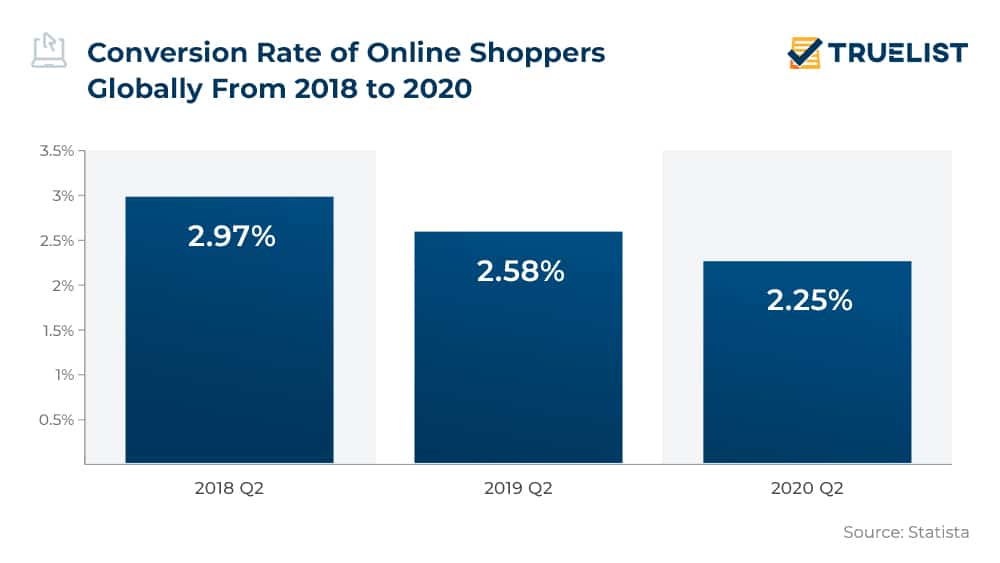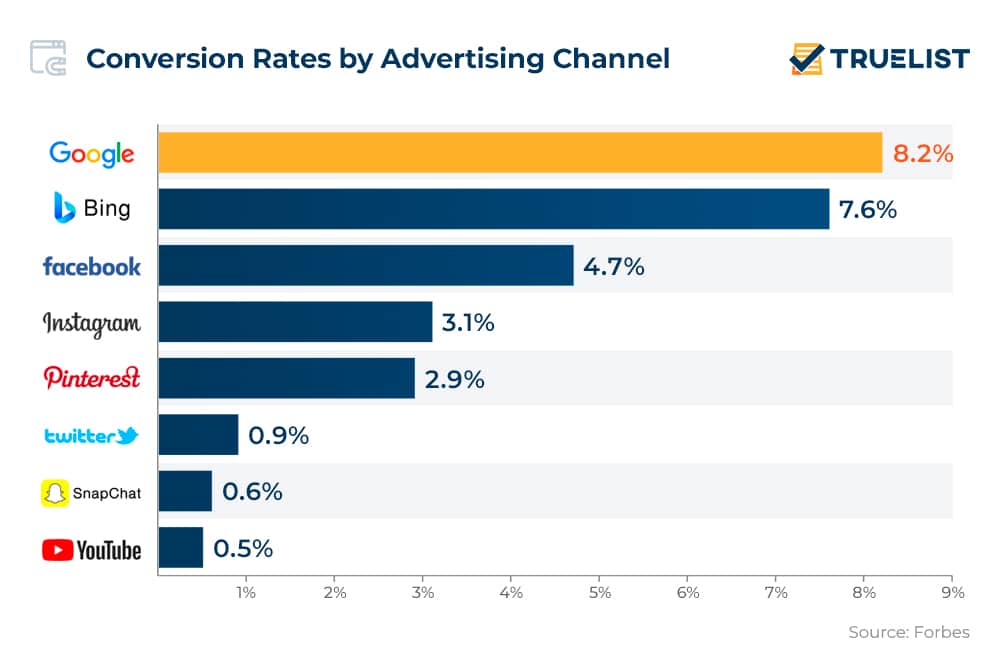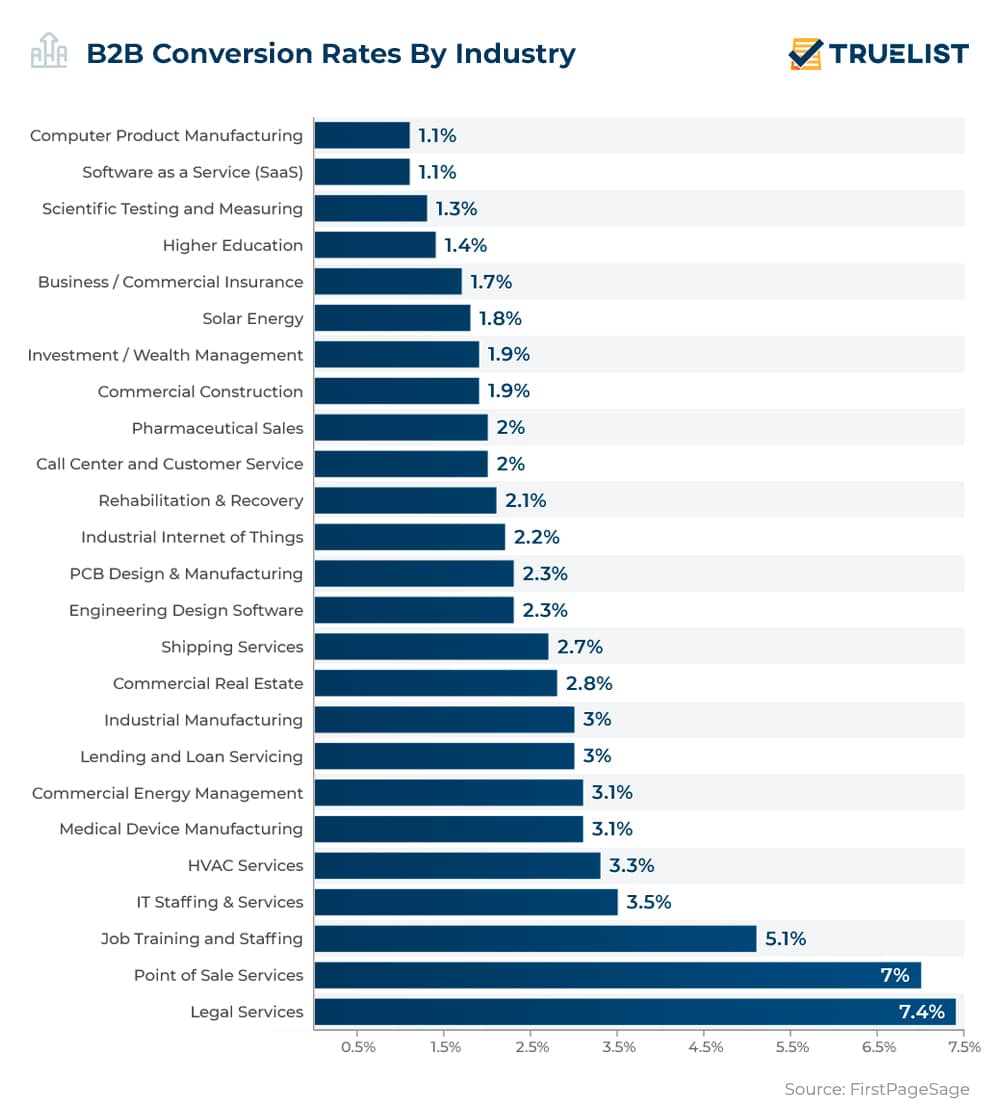Do you spend hours or even days planning, implementing, and analyzing the results of all sorts of tests and research? As a marketer, you are probably investing valuable resources in attracting potential clients. But how much of your time and money do you allocate to optimization? The painful truth is that most websites have no problem generating traffic, but almost all struggle with conversions. That’s why we drafted this list of essential CRO statistics that will hopefully clue you in on how to tweak your strategy and reap the benefits of conversion rate optimization.
CRO Statistics (Editor’s Choice)
- Google has the highest conversion rate at roughly 8%. (Forbes)
- In the B2B space, legal services have the highest conversion rate at 7.4%. (FirstPageSage)
- 22% of businesses are not pleased with their conversion rates. (Outgrow)
- 74% of conversion rate optimization programs deliver higher sales. (Kyleads)
- The average landing page conversion rate is 2.35%. (IMPACT)
- Videos on your landing page can boost your conversions by 86%. (Wishpond)
- Making multiple offers on landing pages will reduce your leads by 266%. (Bluleadz, Unbounce)
Conversion Rate Optimization Statistics Rundown
1. The ecommerce conversion rate stands at 2.17% worldwide.
Online shopping has become an everyday activity of digital life and, as CRO figures show, it was hovering at around 3% throughout 2018. In the second quarter of 2019, however, only 2.58% of the global online website visits actually became purchases, marking a minor decline from 2.72% in the preceding quarter. Although mobile commerce is trying to catch up in revenue and page views, traditional shopping is still the preferred option for many buyers.
(Statista)

2. Mobile ecommerce conversion rates are still low at 1.81%.
In an age of a pandemic, tablets lead the pack when it comes to device-related conversions with a solid rate of 2.92%. The latest conversion rate optimization trends show the average ecommerce conversion rate of desktops in 2020 stood at 1.98%, pointing to a significant drop from 4.32% in Q4 2019. By contrast, with an average rate of 1.81%, mobiles tell an entirely different story indicating that marketers should start paying more for building apps if they wish to meet the needs of their clients (the majority of whom have long gone mobile).
(Monate)
3. At 8%, Google has the highest conversion rate.
Using multiple channels will definitely scale up your conversions, and CRO trends and stats provide some insight to show you the way. Search engines are at the top of the conversion scale (Google in particular) with an incredible 8.2% average ecommerce conversion rate. The second-best among the search engines with a more than satisfactory 7.6% conversion rate, is Bing.
(Forbes)

4. Facebook fitness ads have a 14.29% conversion rate.
Facebook has a relatively high average conversion rate at 9.21%, as social media conversion rate statistics confirm. This figure, however, varies quite a lot across industries. Fitness ads, for example, convert at as high as 14.29%. On the other hand, for other industries such as retail, posting ads on Facebook does not pay off as much with the average social media conversion rate standing at 3.26%.
(Wordstream)
5. With user-generated content, Instagram delivers a 4.5% conversion rate.
According to social media conversion rate statistics, user-generated Instagram posts achieve a much higher (4.5%) conversion rate. And with Instagram being a platform with over 1 billion users and a potential advertising reach of 928 million users, it is more than a convenient channel for driving sales as long as you leave it up to its users to do the advertising. At the end of the day, 89% of Instagram marketers do so by letting influencers do the promotion and selling.
(Omnicore Agency)
6. The average loading time after most visitors leave a website altogether is less than two seconds.
Website conversion rate statistics give information on how much your potential customers value the user experience while on your website. You have a thin margin for error when it comes to anything less than perfection for those prospects who make it to your website from search results. Loading time is one of the most significant factors that determine whether or not a conversion will take place, and waiting for too long is bad any way you look at it.
(Entrepreneur)
7. In the B2B space, legal services have the highest conversion rate at 7.4%.
Conversion rate optimization stats also indicate that the points of sale (POS) services see the second-best average conversion rate at 7%. The latest data on the average B2B lead conversion rate also points to an average of 5.1% in the staffing services, 3.5% in IT staffing and services, and a 3.3% and 3.1% rate in HVAC services and medical device and equipment manufacturing, respectively. In contrast, the lowest conversion rate is noted by the computer product manufacturing sector (1.1%).
(FirstPageSage)

8. 68% of small businesses don’t have CRO strategies.
CRO statistics indicate that—as surprising as it may sound—nearly two-thirds of small companies don’t have a structured or documented CRO strategy in place. How can you track your success and learn from your failures unless you have a written trail of your performance? Implementing the right CRO strategy is the ultimate starting point in crafting the perfect plan and long-term milestones for your online business.
(CXL)
9. 82% of marketers admit it is very or somewhat challenging to learn how to track and test conversion rates effectively.
Other conversion rate optimization statistics indicate that eight out of 10 marketers find it very or somewhat challenging to perform CRO effectively. Learning the tricks of effective CRO does require a complete and detailed understanding of all of the necessary components, meaning you first need to comprehend activities such as conversion rate tracking and testing thoroughly. Nothing happens overnight, so keep at it until you start seeing actual results.
(Transaction Agency)
10. 74% of conversion rate optimization programs deliver higher sales.
CRO facts reveal that marketers with established conversion rate optimization programs see a significant increase in sales. Since CRO programs deliver excellent results in 74% of the cases, this means that dedicating more attention to CRO will inevitably lead to higher revenue in three out of four cases. So what marketers need to do is revise what works in their specific program and just go ahead and focus on doing more of that.
(Kyleads)
11. 22% of businesses are not pleased with their conversion rates.
The majority of marketers believe their average conversion rate should be a two-digit figure which is practically the reason why CRO stats point to a significant 22% being dissatisfied with their numbers. What many marketers fail to see, however, is that the average conversion rate hovers at around 3% and varies greatly based on the industry.
(Outgrow)
12. Top Performers convert 52 out of each 100 target contacts.
Conversions happen only if and when customers genuinely get to know your business. And this takes time and effort. CRO statistics indicate that nearly half of businesses today contact their potential customers repeatedly before managing to sell their products or services. Actually, only 8% of sales happen with one contact only and over 48% of sales take place between four to ten contacts or more. This means marketers need to focus more on follow-up conversations with their leads and should come up with attractive content to secure buying customers.
(RAIN Group)
13. 85% of marketers are not trying hard enough to get customers back to their website.
As you can surmise from the stat above, no one is ready to give away their money on the “first date”. Sales conversion rate statistics unfortunately confirm that most marketers are not trying hard enough to win over “hard-to-get” customers who obviously need several dates before they decide to make a purchase. So, in trying to convert your lead, try a more innovative approach because you might not be able to change the product, but you can definitely change how you promote it.
(Kyleads)
CRO & Landing Page Statistics
14. The average landing page conversion rate is 2.35%.
What this means is that out of 10 people who visit your website, two or three will perform the action you want them to. Meanwhile, the average landing page conversion rates of 25% of the top-performing sites stand at 5.31% or more. By contrast, the best 10% of websites enjoy an 11.45% landing page conversion rate or higher.
(IMPACT)
15. Almost 50% of marketers build a new landing page for each of their marketing campaigns.
A total of 48% of marketers rely on a new landing page whenever they launch a marketing campaign, as confirmed by landing page statistics. For these marketers, following the best practices in delivering new and fresh content to customers has proven very effective in boosting conversion rates. The remaining 52% just reuse the old landing pages, which results in the delivery of ‘old’ content or rather, content that is geared towards a specific campaign, and this often backfires leading to a message mismatch and higher bounce rates.
(Kyleads)
16. Videos on your landing page can boost your conversions by 86%.
Video conversion rate statistics are more than clear: the days of the video revolution are already upon us and 87% of marketers are already part of it. With faster internet speeds and cheaper data, more and more users tend to watch videos on their devices. Don’t lag behind the trend; go ahead and put some video on your landing page to see these conversions grow. Make sure, however, that your content provides actual value to your readers and visitors.
(Wishpond)
17. Conversion rates will jump by 100% if you remove the navigation from your landing page.
According to the latest landing page conversion statistics, to reach a 100% boost on your landing page conversion rates, the leading elements on your landing page should be specifically oriented to guide the visitor to take a single action, anything extra would only serve as a distraction. Page navigation elements, for example, often distract visitors from performing the action you intend them to, so getting rid of them would be a smart move.
(HubSpot)
18. Changing the CTA to ‘Click here’ boosts conversion rates by 30%.
The anchor text you use for your form CTA buttons can significantly reduce or increase your conversions. Landing page conversion statistics mention that using ‘submit’ as your CTA anchor text will dip your conversions by as much as 3%. On the other hand, the less pushy ‘click here’ or ‘go’ can boost your landing page conversion rate by 30% or 25%, respectively. Similarly, using anchors like ‘download’ or ‘register’ is a much better option than ‘submit’, as they can add 15% or 10% to your conversions.
(Funnel Overload)
19. Forms requesting visitors’ telephone numbers can reduce conversion rates by 48%.
Landing page and conversion rate optimization stats are definitely not positive about sites that ask visitors to provide their phone numbers. According to A/B tests run by digital marketing agencies, the drop can be from 5% to as much as 48%. Think about it: no one likes to just give away their phone number and the majority of people consider it a sort of violation of their privacy, so unless it is absolutely necessary for your business, avoid asking for this information.
(Vital Design)
20. Conversion rates are higher by 3% on landing pages that do not ask visitors about their age.
One of the undisputed conversion rate optimization facts is that asking visitors to share their age directly impacts conversion rates in a negative way. One particular explanation is that many internet users feel asking their age is somewhat intrusive to their privacy. Regardless of whether you share this view, do your best to take note of this particular fact if you’re looking to improve your conversion rates.
(Hubspot)
21. Website conversion rate statistics show that 62% of B2B companies have six or fewer landing pages.
The higher the number of pages, the better the chances for more conversions. And data related to landing page conversion rates indicate that companies generate more leads when they increase the number of landing pages from 10 to 15. In fact, in doing so, the majority of companies boast 55% higher leads.
(Kyleads)
22. Making multiple offers on landing pages will reduce your leads by 266%.
Having multiple offers on your landing page is bad for business as landing page statistics indicate it will get you 266% fewer leads than a landing page with just one offer. CRO data also shows that asking your potential leads to fill in forms that have six fields or more will deliver a conversion rate of 15% while forms with fewer fields (3 to 5) have a 20% higher rate. The ones with three fields or less do even better with 25%.
(Bluleadz, Unbounce)
23. 61% of companies test their landing pages up to five times per month.
Landing page statistics show that 62% of marketers use CRO testing as a way to improve and scale lead generation on their landing pages. And a little over 61% of companies test their landing pages up to five times per month. In regards to the type of testing, A/B tests appear to be the most popular form of CRO testing and are used by 56% of marketers.
(SessionCam)
Frequently Asked Questions
What is conversion rate optimization?
CRO is the process of increasing the percentage of your website visitors who proceed to take a pre-determined action. This action can involve becoming a customer, filling out a form, or anything in between. The entire CRO process is vast and complex. It involves understanding your users’ behavior, how and what actions they end up taking, as well as which goals your web page fails to achieve and why.
(Hotjar)
What is the purpose of conversion rate optimization?
The purpose of optimizing your conversion rates is straightforward: you’re looking to ensure that you have the maximum percentage of people on your website who are performing the tasks you’ve set for them. Many websites today focus on having the visitor make a purchase (something that’s known as macro-conversion). However, before a user completes this macro-conversion, there are smaller conversions that can take place. One example of such micro-conversions is signing up for newsletters.
(Optimizely)
What are the benefits of conversion rate optimization?
Some of the direct benefits of CRO include stronger trust, a better user experience, higher scalability, improved ROI, as well as enhanced customer insights. You must know where to optimize, what to optimize, as well as specifically for whom to optimize.
(HelloBear)
Conclusion
Conversion rate optimization can help you achieve higher sales, lower customer acquisition costs, and increased turnover all at once. And even though there is no recipe for certain success, our list of the most effective CRO statistics is an excellent starting point for you to start building your profitable online business. After all, there is nothing better than solid facts and figures to lead your way on what you should or shouldn’t do.
Sources: Statista, Monate, Forbes, Wordstream, Omnicore Agency, Entrepreneur, FirstPageSage, CXL, Transaction Agency, Kyleads, Outgrow, RAIN Group, IMPACT, Wishpond, HubSpot, Funnel Overload, Vital Design, Hubspot, Bluleadz, Unbounce, SessionCam, Hotjar, Optimizely, HelloBear

